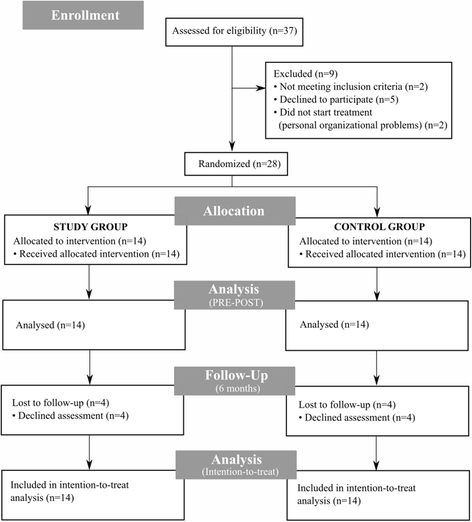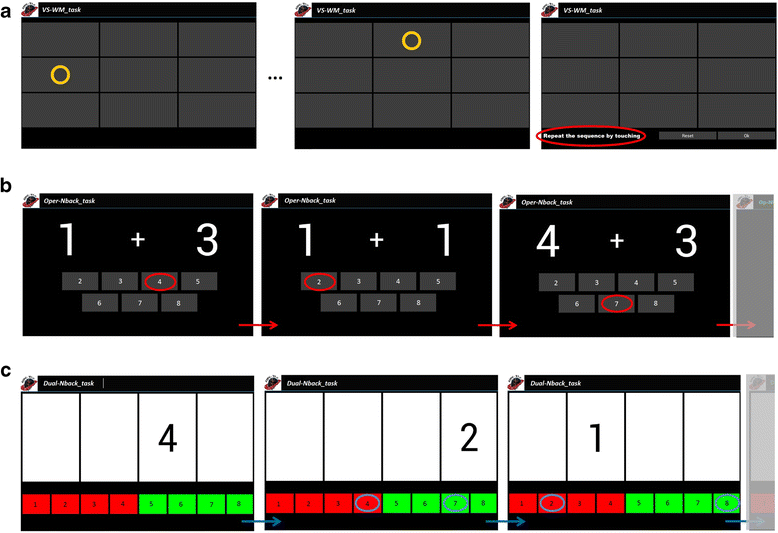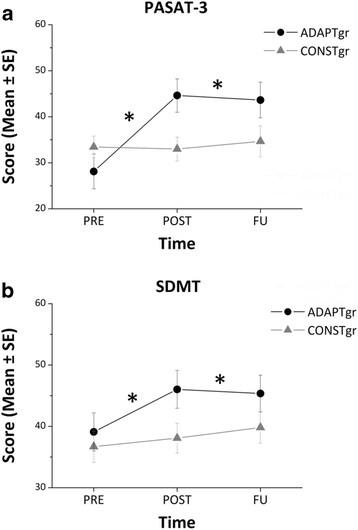Adaptive vs. non-adaptive cognitive training by means of a personalized App: a randomized trial in people with multiple sclerosis
- PMID: 27716336
- PMCID: PMC5050994
- DOI: 10.1186/s12984-016-0193-y
Adaptive vs. non-adaptive cognitive training by means of a personalized App: a randomized trial in people with multiple sclerosis
Abstract
Background: Cognitive impairment is common in multiple sclerosis (MS), but the definition of the best cognitive rehabilitation tools and features is still an open issue among researchers. The aims of the present study were to evaluate the effectiveness of COGNI-TRAcK (a customized application software delivering personalized working memory-based exercises) on cognitively impaired people with MS and to investigate the effects of an adaptive vs. a non-adaptive cognitive training administered by means of COGNI-TRAcK.
Methods: Twenty eight patients (20 women, age 47.5 ± 9.3 years, Expanded Disability Status Scale score 3.8 ± 1.9) were randomized in two homogeneous groups, both performing a 8-week home-based cognitive rehabilitation treatment by means of COGNI-TRAcK. The study group (ADAPT-gr) underwent an adaptive training given by the automatic adjustment of tasks difficulty to the subjects' performance, whilst the control group (CONST-gr) was trained at constant difficulty levels. Before and after the treatment, patients' cognitive status was assessed using a gold standard neuropsychological evaluation. Moreover, the mostly affected cognitive domains in MS (i.e., attention, concentration and information processing speed) were also assessed 6 months after the end of the treatment.
Results: The analysis of variance showed a significant Group*Time interaction in six out of ten tests of the cognitive evaluation. Post-hoc analysis revealed a significant improvement between the performances before and after the intervention only in the ADAPT-gr in tests evaluating verbal memory acquisition (p <0.05) and delayed recall (p = 0.001), verbal fluency (p = 0.01), sustained attention, concentration and information processing speed (p < 0.01). This last effect was maintained also after 6 months (p < 0.05).
Conclusions: We concluded that COGNI-TRAcK represents a suitable tool to administer a personalized training to cognitively impaired subjects and that an adaptive working load is a crucial feature determining the effectiveness of cognitive treatment, allowing transfer effects to several cognitive domains and long-term maintenance of results.
Keywords: Adaptive working load; Application software; Cognitive rehabilitation; Multiple sclerosis; Personalized treatment.
Figures



References
Publication types
MeSH terms
LinkOut - more resources
Full Text Sources
Other Literature Sources
Medical

